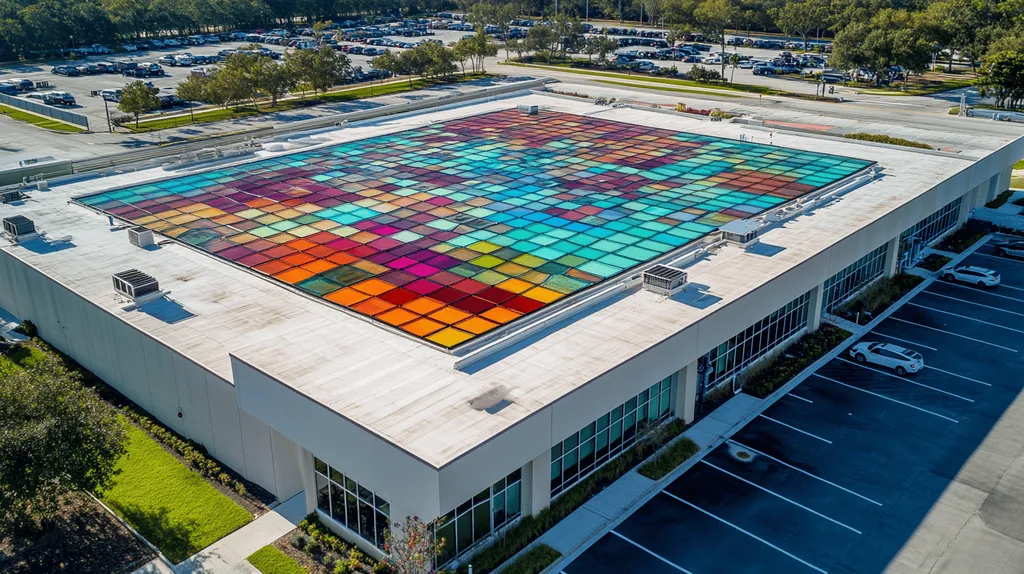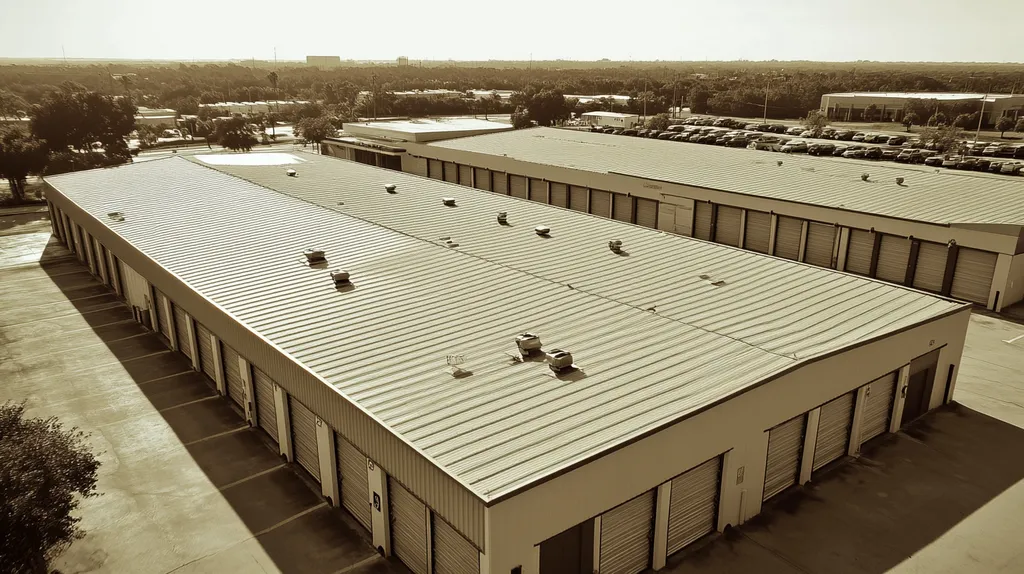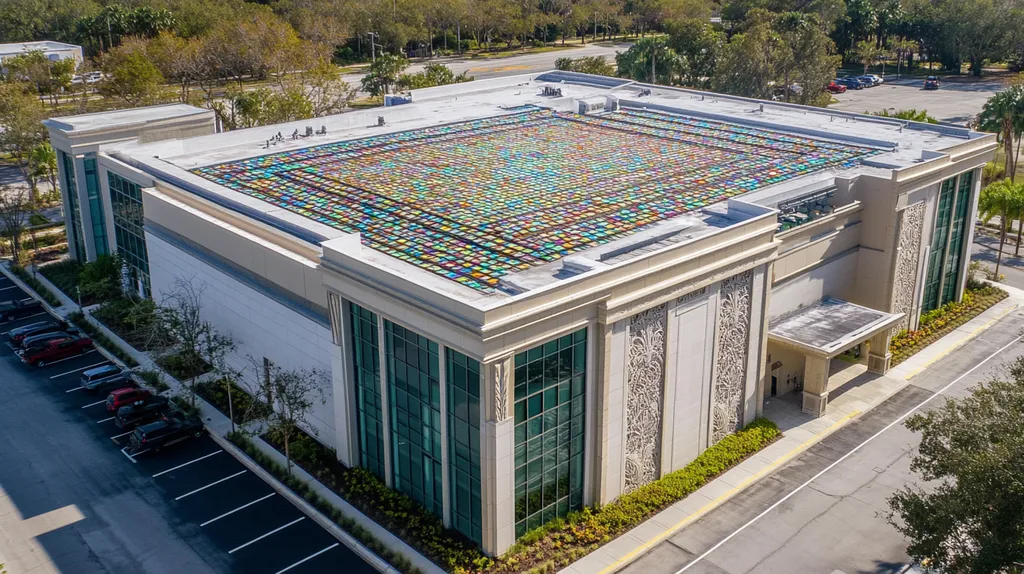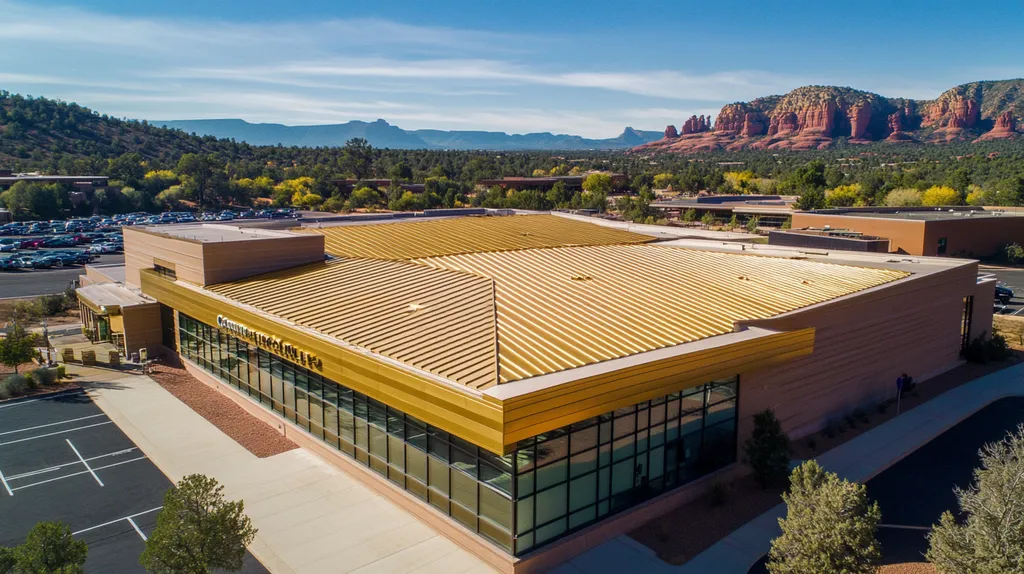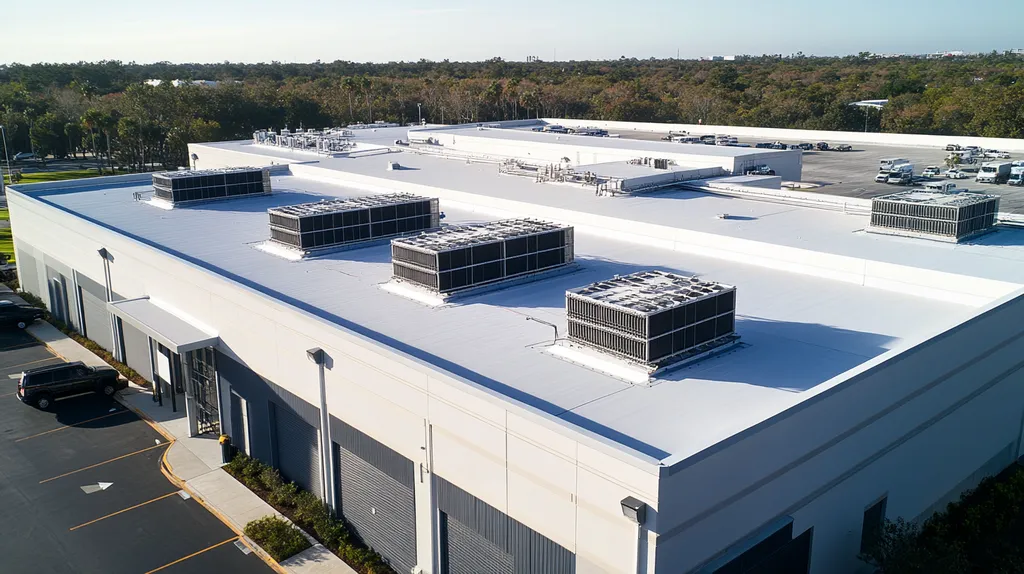Commercial buildings waste over $6 billion annually on inefficient rooftop lighting that drains energy budgets while creating maintenance nightmares for facility managers.
Traditional scattered pole-mounted fixtures and outdated technologies consume 40% more electricity than necessary while delivering inconsistent coverage and frequent failures.
Integrated lighting systems embedded directly into roof structures offer a transformative solution that can slash energy consumption by 60-75% while eliminating the complexity of conventional installations.
Understanding the basics, applications, costs, and common challenges of these systems determines whether facility managers achieve meaningful savings or simply install expensive equipment that underperforms.
SECTION 1: THE BASICS EXPLAINED
Commercial buildings waste millions of dollars annually on inefficient lighting systems that drain energy budgets and compromise sustainability goals. Traditional rooftop lighting installations—scattered pole-mounted fixtures, poorly positioned wall lights, and outdated technology—create unnecessary complexity while delivering subpar performance.
Integrated lighting systems embedded directly into commercial roof structures offer a transformative solution that slashes energy consumption, reduces maintenance headaches, and positions buildings for long-term operational success.
What It Is (In Plain Language)
Integrated lighting embeds LED fixtures directly into roof structures rather than mounting them on separate poles or walls. These systems become part of the building envelope itself, creating seamless illumination without the visual clutter of traditional installations.
The technology centers on strategically placed LED lights that work with smart sensors and automated controls. Motion detectors, daylight sensors, and occupancy monitors adjust brightness levels automatically throughout the day.
For facility managers, this means one unified system instead of dozens of independent fixtures. Wiring runs through the roof structure in organized pathways, eliminating the maze of cables typical in conventional installations.
Modern integrated systems can illuminate parking areas, loading docks, walkways, and building perimeters from roof-mounted positions. The fixtures blend into roofing materials or sit flush with roof surfaces, maintaining clean architectural lines.
Smart controllers allow remote monitoring and programming through building management systems. Facility teams can adjust lighting schedules, monitor energy usage, and receive maintenance alerts from centralized dashboards.
Why It Matters (To Your Building)
Lighting typically consumes 20-40% of a commercial building’s electricity budget, making efficiency improvements critically important for operational costs. Integrated systems deliver dramatic energy reductions through LED technology combined with intelligent controls that eliminate waste.
Energy efficiency is at the heart of modern lighting solutions, and roof overhang recessed lights excel in this regard by utilizing LED technology that significantly reduces energy consumption compared to traditional lighting systems. Proper design and arrangement of these fixtures can minimize the need for excessive heating or cooling by preserving indoor temperatures. (source: PacLights)
Many jurisdictions now offer substantial rebates and tax incentives for energy-efficient lighting upgrades. These financial programs can offset 30-50% of installation costs, making integrated solutions highly attractive investments.
Properly designed integrated lighting eliminates light pollution and glare issues that plague traditional installations. This creates safer, more comfortable environments for employees and visitors while meeting increasingly strict municipal lighting ordinances.
Buildings with integrated lighting systems command higher property values and attract quality tenants who prioritize sustainability. The technology demonstrates forward-thinking facility management and commitment to environmental responsibility.
How It Works
Integrated lighting systems position LED fixtures within roof assemblies or mount them flush with roof surfaces. Engineering teams calculate optimal placement to maximize coverage while minimizing energy consumption and glare.
Daylight sensors continuously monitor ambient light conditions and dim artificial lighting as natural sunlight increases. Motion sensors detect activity in parking lots, loading areas, and walkways, bringing lights to full brightness only when needed.
Smart controllers process sensor data and adjust lighting output accordingly. During overnight hours, systems might operate at 20% capacity for security purposes, then ramp up to full brightness when motion is detected.
The roof’s reflective surfaces and fixture angles work together to direct light precisely where needed. This engineered approach eliminates the uneven coverage and wasted illumination common with traditional pole-mounted fixtures.
Centralized wiring systems connect all fixtures through protected roof pathways, reducing electrical complexity and maintenance requirements. Facility teams can monitor system performance and schedule maintenance through building management platforms.
SECTION 2: PRACTICAL APPLICATIONS
Commercial buildings waste approximately $6 billion annually on inefficient lighting systems that operate when spaces are empty or during peak daylight hours. Traditional rooftop lighting creates maintenance nightmares with scattered fixtures, complex wiring runs, and unpredictable failure patterns.
Integrated lighting systems transform these challenges into competitive advantages by embedding intelligence directly into roof structures. Understanding where and when to deploy these systems—and how they interact with other building technologies—determines whether facility managers achieve meaningful energy savings or merely install expensive equipment.
Common Uses & Examples
Warehouse and distribution centers represent the most compelling applications for integrated rooftop lighting systems. These facilities typically operate 16-24 hours daily with massive exterior areas requiring consistent illumination for loading docks, truck courts, and employee parking.
Manufacturing plants use integrated lighting to illuminate rooftop mechanical equipment areas where technicians perform regular maintenance after dark. The embedded sensors automatically brighten work zones when motion is detected, then dim to security levels when areas become vacant.
Office complexes and retail centers deploy integrated systems primarily for parking lot illumination and building perimeter security. Fixtures mounted flush with roof edges eliminate the forest of light poles that complicate snow removal, landscaping, and vehicle traffic flow.
Healthcare facilities and educational campuses benefit from integrated emergency lighting that activates automatically during power outages. These systems maintain critical illumination for evacuation routes and emergency vehicle access without relying on backup generators.
Skylights reduce energy consumption by 20-60% while improving occupant well-being, and when combined with integrated artificial lighting, create layered systems that respond to changing daylight conditions throughout the day. (source: Velux Commercial)
When You Need It Most
Rising utility costs trigger immediate interest in integrated lighting systems, particularly when electricity rates increase faster than rental income or operational budgets. Buildings facing 15-25% annual lighting cost increases find that integrated systems pay for themselves within 3-4 years through reduced consumption.
Roof replacement projects create ideal timing for integrated lighting installation since electrical infrastructure is already being updated and roof surfaces are accessible. Installing these systems during planned roofing work reduces labor costs by 40-60% compared to standalone lighting projects.
Municipal lighting ordinances increasingly restrict light pollution and mandate energy efficiency standards that older systems cannot meet. Facilities receiving code violation notices or facing compliance deadlines often discover that integrated lighting provides the most cost-effective path to regulatory compliance.
Insurance requirements drive adoption when carriers offer premium reductions for buildings with modern security lighting and automated emergency systems. These financial incentives, combined with improved safety performance, create compelling business cases for facility managers.
Tenant demands for sustainable building features make integrated lighting essential for maintaining competitive lease rates. Properties without energy-efficient systems face higher vacancy rates and longer lease-up periods in markets where sustainability matters to tenants.
Interactions With Other Systems
Building automation systems multiply the efficiency gains from integrated lighting by coordinating illumination with HVAC schedules, occupancy patterns, and weather conditions. This integration prevents lights from operating at full brightness when buildings are empty or when natural daylight provides adequate illumination.
Rooftop solar installations work synergistically with integrated lighting systems by providing renewable power during peak demand periods. Smart controllers prioritize solar energy for lighting loads, reducing grid consumption and supporting net-zero energy targets.
Fire safety systems integrate with lighting controls to ensure emergency illumination activates immediately when fire alarms trigger. This coordination eliminates the delays and failures common with independent emergency lighting circuits that may not activate properly during actual emergencies.
Security surveillance systems benefit from integrated lighting that provides consistent illumination for cameras while responding to motion detection signals. When security systems detect unauthorized activity, integrated lighting can flood specific zones with bright illumination while alerting monitoring services.
Energy management platforms collect performance data from integrated lighting systems to optimize building-wide efficiency strategies. This data reveals usage patterns, identifies maintenance needs, and demonstrates compliance with energy codes and sustainability reporting requirements.
SECTION 3: KEY TERMINOLOGY DECODED
Commercial property owners lose thousands annually because they misunderstand lighting specifications and make purchasing decisions based on incomplete technical knowledge. A facility manager who confuses lumens with lux might install fixtures that consume 40% more energy than necessary while delivering inadequate illumination.
Integrated lighting systems involve complex interactions between optical performance, electrical consumption, and building envelope characteristics that require precise terminology to evaluate effectively. Understanding these terms transforms technical specifications from confusing jargon into actionable intelligence for smarter energy investments.
Essential Terms Explained
Lumens measure total light output from a fixture, while watts indicate electrical power consumption—the relationship between these numbers determines energy efficiency. A 5,000-lumen LED fixture consuming 50 watts delivers 100 lumens per watt, significantly outperforming traditional fixtures that produce only 15-20 lumens per watt.
Color temperature, measured in Kelvins, affects both energy consumption and occupant comfort in commercial spaces. Cool white light at 5,000K provides excellent visibility for security applications but may require higher wattages to achieve comfortable illumination levels compared to warm white alternatives at 3,000K.
Efficacy represents the ultimate efficiency measurement, expressing lumens per watt to help facility managers compare different lighting technologies objectively. Modern integrated LED systems achieve 120-150 lumens per watt, while older metal halide fixtures typically deliver only 65-80 lumens per watt.
Light distribution patterns describe how fixtures spread illumination across surfaces, directly impacting the number of fixtures required for adequate coverage. Type III distribution patterns work best for parking lot applications, while Type V patterns suit building perimeter lighting where uniform coverage matters most.
Industry Jargon Translated
Photometric data provides scientific measurements of light output and distribution patterns that determine whether proposed lighting designs will meet performance requirements. These reports include candela distributions, illuminance calculations, and spacing criteria that prevent over-lighting or under-lighting expensive commercial installations.
Daylight harvesting describes automated systems that adjust artificial lighting output based on available natural light, potentially reducing energy consumption by 30-50% in perimeter areas. Skylights reduce energy consumption by 20-60% by providing natural light while balancing thermal performance through proper glazing selection and sizing to avoid excessive heat gains. (source: Velux Commercial)
Demand response programs allow utility companies to remotely reduce lighting loads during peak energy periods, providing rebates that can offset 15-25% of annual electricity costs. Integrated lighting systems with smart controls participate automatically in these programs without affecting building security or safety requirements.
Light pollution regulations limit upward light spillage and glare that affects surrounding properties, requiring precise cutoff angles and shielding that traditional pole-mounted fixtures struggle to achieve consistently. Integrated roof-mounted systems provide better compliance through controlled beam angles and strategic placement.
Measurement & Units Simplified
Lux measures illumination intensity reaching a surface, helping facility managers verify that lighting installations provide adequate brightness for specific applications. Parking lots typically require 5-10 lux for basic security, while loading docks need 50-100 lux for safe material handling operations.
Footcandles represent the American equivalent of lux measurements, with one footcandle equaling approximately 10.76 lux in practical lighting calculations. Many building codes and insurance requirements specify minimum footcandle levels rather than lux, making conversion essential for international lighting manufacturers.
Power density, measured in watts per square foot, helps evaluate overall energy efficiency across entire building areas rather than individual fixtures. Integrated lighting systems often achieve 0.6-0.8 watts per square foot for exterior applications, compared to 1.2-1.5 watts per square foot for conventional pole-mounted installations.
Maintained illumination accounts for light output degradation over time, ensuring that aging LED fixtures continue meeting minimum brightness requirements throughout their 15-20 year service lives. Proper maintenance factors prevent costly retrofits and ensure consistent performance as integrated systems mature.
SECTION 4: DECISION FACTORS
Commercial property owners frequently make lighting decisions based on lowest bid pricing, only to discover their energy bills increase by 25-40% annually due to inefficient systems and unexpected maintenance costs. Traditional lighting procurement focuses on upfront expenses while ignoring operational performance, equipment lifespan, and integration complexity that determine real profitability.
Integrated rooftop lighting systems require comprehensive evaluation beyond initial price comparisons. Smart facility managers analyze total cost of ownership, performance characteristics, and durability factors to avoid costly mistakes that plague buildings for decades.
Cost Considerations
Initial equipment costs for integrated LED lighting systems run 30-50% higher than conventional fixtures, but energy savings typically recover this premium within 24-36 months through reduced electricity consumption. High-quality LED systems consume 60-75% less power than traditional metal halide or fluorescent alternatives while providing superior light output.
Installation expenses vary dramatically based on timing and roof conditions. Coordinating lighting installation with planned roof replacements reduces labor costs by 40-60% compared to standalone projects that require separate roof penetrations and weatherproofing.
Maintenance costs represent hidden expenses that distinguish quality systems from budget alternatives. Premium integrated lighting requires service calls every 3-4 years, while cheaper systems often need annual repairs and component replacements that quickly eliminate initial savings.
Utility rebates and energy incentives can offset 25-40% of total project costs in many jurisdictions. These programs typically require specific efficiency ratings and professional installation, making qualified contractors essential for maximizing financial benefits.
Financing options through energy service companies allow buildings to implement integrated lighting with zero upfront costs, using guaranteed energy savings to fund monthly payments over 7-10 year terms.
Performance Trade-offs
Energy efficiency improvements sometimes conflict with immediate performance expectations, particularly when upgrading from over-illuminated conventional systems. Properly designed efficient lighting provides adequate brightness while eliminating the excessive light levels that waste energy and create glare problems.
Smart controls and sensors enhance efficiency but introduce complexity that can impact reliability if not properly specified. Motion sensors and daylight harvesting systems require professional calibration to avoid nuisance shutoffs or inadequate dimming that compromises safety.
Color temperature selection affects both energy consumption and occupant comfort in commercial applications. Cooler color temperatures provide better visibility for security cameras but may require higher wattages to achieve comfortable illumination levels compared to warmer alternatives.
Light distribution patterns directly impact the number of fixtures required for adequate coverage. Type III distributions excel for parking lot illumination, while Type V patterns suit building perimeter applications where uniform coverage matters most for safety.
Roof overhang recessed lights excel in energy efficiency by utilizing LED technology that significantly reduces energy consumption compared to traditional lighting systems, while proper design and arrangement minimize heating and cooling loads by preserving optimal indoor temperatures. (source: PacLights)
Lifespan & Durability Factors
Roof-mounted lighting endures extreme temperature fluctuations, UV exposure, and moisture infiltration that quickly destroy inadequately protected systems. Commercial-grade fixtures with IP65 or higher ratings resist weather penetration while maintaining electrical integrity throughout 15-20 year service lives.
LED fixture quality varies dramatically between manufacturers, with premium products delivering 70,000+ hour lifespans compared to budget alternatives that fail within 25,000-30,000 hours. This performance difference translates to decades of reliable operation versus frequent replacement cycles that disrupt building operations.
Proper installation techniques determine whether integrated lighting enhances or compromises roof membrane integrity. Qualified contractors use appropriate flashing, sealants, and mounting systems that accommodate thermal movement without creating leak paths.
Warranty coverage reveals manufacturer confidence in product durability, with leading brands offering 10-year comprehensive warranties compared to 2-3 years for budget alternatives. Extended warranties protect against premature failures while ensuring replacement parts remain available throughout system lifespans.
Environmental certifications like DLC Premium and ENERGY STAR indicate products tested for commercial applications under realistic operating conditions. These certifications help facility managers avoid untested products that may fail prematurely in demanding rooftop environments.
SECTION 5: COMMON CHALLENGES
Commercial facilities waste approximately $2.4 billion annually on lighting-related failures, maintenance emergencies, and premature system replacements that could have been prevented through proper planning and early intervention. Integrated rooftop lighting systems face unique challenges from weather exposure, electrical complexity, and installation mistakes that compromise both performance and building integrity.
Understanding common failure patterns and implementing proactive monitoring helps facility managers protect their lighting investments while maintaining the energy efficiency gains that justified these systems originally. Recognition of warning signs and preventative strategies determines whether integrated lighting delivers decades of reliable service or becomes a costly maintenance burden.
Frequent Problems & Solutions
Water infiltration represents the most destructive challenge facing integrated rooftop lighting systems, with improperly sealed fixtures causing electrical failures and roof membrane damage within 2-3 years of installation. Moisture penetration occurs when contractors use inadequate flashing details or fail to accommodate thermal movement that opens seal gaps over time.
The solution requires marine-grade sealants, proper flashing systems, and fixtures rated IP65 or higher for weather resistance. Professional installation teams must create watertight barriers that flex with thermal cycling while maintaining electrical integrity throughout 15-20 year service lives.
Electrical surge damage destroys integrated lighting systems during thunderstorms and utility switching events, particularly in facilities lacking adequate protection devices. Rooftop-mounted fixtures act as lightning attractors, channeling dangerous voltage spikes directly into building electrical systems and causing cascading failures across multiple circuits.
Installing dedicated surge protection devices at both panel and fixture levels prevents voltage spikes from reaching sensitive LED drivers and control circuits. Quality surge suppressors cost 3-5% of total project expenses while eliminating 80-90% of weather-related electrical failures.
Lighting accounts for 17% of all electricity consumed in U.S. commercial buildings; upgrading to LEDs can reduce lighting energy use by 90% and decrease heat output significantly. However, thermal management problems occur when fixtures overheat due to inadequate ventilation or incompatible mounting systems that trap heat against roof surfaces. (source: ENERGY STAR)
Proper thermal design includes heat sinks, ventilation gaps, and mounting systems that allow airflow around fixtures. These design features prevent premature LED degradation while maintaining optimal energy efficiency throughout system lifespans.
Warning Signs To Watch For
Flickering or dimming lights indicate electrical connection problems that worsen rapidly in rooftop environments where thermal cycling stresses wiring terminations. These symptoms often precede complete fixture failures that require emergency repairs and compromise building security lighting.
Facility managers should investigate any changes in light output immediately, checking for loose connections, corroded terminals, or damaged conductors. Early intervention prevents minor electrical issues from escalating into major system failures requiring extensive rewiring.
Visible water stains, rust, or corrosion around fixture mounting points signal seal failures that allow moisture penetration into electrical components and roof assemblies. These warning signs appear months before actual failures occur, providing opportunities for preventative maintenance.
Regular roof inspections should document fixture conditions with photographs, tracking any changes in seal integrity or visible deterioration. Professional assessments every six months help identify problems while repairs remain simple and inexpensive.
Unexpected increases in energy consumption or utility costs may indicate failing LED drivers, malfunctioning sensors, or control system problems that cause lights to operate at full brightness continuously. Energy monitoring systems can detect these anomalies within days rather than waiting for monthly utility bills.
Smart meters and building management systems provide real-time energy data that reveals lighting performance problems immediately. Facility teams can investigate consumption spikes and restore efficient operation before energy waste accumulates significantly.
Preventative Approaches
Scheduled maintenance programs prevent most integrated lighting failures through systematic cleaning, inspection, and testing performed every 6-12 months depending on environmental conditions. Preventative maintenance costs 60-70% less than reactive repairs while extending system lifespans significantly.
Professional maintenance includes lens cleaning, electrical connection testing, seal inspection, and photometric measurements to verify light output remains within specifications. These services maintain energy efficiency while identifying potential problems before they cause failures.
Quality specification during initial design eliminates many common problems by requiring fixtures rated for local climate conditions, professional-grade mounting systems, and redundant safety features. Investing 10-15% more in premium components prevents 70-80% of typical failure modes.
Specifications should mandate UL listing for wet locations, impact resistance ratings appropriate for rooftop environments, and warranty coverage that protects against premature failures. These requirements ensure integrated lighting systems deliver reliable performance throughout their intended service lives.
Professional installation by certified contractors who understand both roofing and electrical systems prevents most water infiltration and electrical problems that plague integrated lighting projects. Qualified installers cost 20-30% more than general contractors but eliminate 90% of installation-related failures.
Proper contractor selection requires verification of roofing certifications, electrical licenses, and manufacturer training credentials. These qualifications ensure installations meet code requirements while protecting building warranties and insurance coverage.
SECTION 6: NEXT STEPS & RESOURCES
Commercial property owners delay integrated lighting decisions for an average of 18 months while energy costs increase 8-12% annually, resulting in thousands of dollars in unnecessary utility expenses. Facility managers who postpone efficient lighting upgrades face mounting pressure from rising electricity rates, stricter energy codes, and tenant demands for sustainable building features.
Smart property owners recognize that integrated lighting projects require careful provider selection, compliance verification, and ongoing education to maximize energy savings and avoid costly mistakes. The difference between successful installations and expensive failures often depends on asking the right questions upfront and understanding industry standards that govern commercial roofing applications.
Questions To Ask Providers
Demand specific performance data showing how proposed systems achieve energy efficiency targets while maintaining adequate illumination levels for your facility’s applications. Providers should present photometric calculations, energy consumption projections, and maintenance schedules that demonstrate total cost of ownership over 15-20 year equipment lifespans.
Verify contractor certifications for both electrical and roofing work since integrated systems require expertise in weatherproofing, thermal management, and code compliance. Ask for recent project references where clients achieved documented energy savings and experienced minimal maintenance issues during the first five years of operation.
Confirm warranty coverage includes both fixture performance and roof membrane integrity since improper installations can create leak paths that cost thousands in emergency repairs. Quality providers offer comprehensive warranties covering electrical components, weatherproofing, and workmanship defects for minimum 10-year periods.
Inquire about smart control capabilities and building management system integration that maximize efficiency through automated scheduling, occupancy sensing, and daylight harvesting. These features typically deliver 30-50% additional energy savings beyond basic LED upgrades while improving building security and occupant safety.
Industry Standards & Guidelines
Illuminating Engineering Society (IES) guidelines establish minimum light levels and uniformity requirements for commercial exterior applications while promoting energy-efficient design practices. These standards help facility managers specify appropriate illumination without over-lighting that wastes energy or under-lighting that compromises safety and security.
National Electrical Code (NEC) sections governing rooftop installations mandate proper grounding, surge protection, and weatherproof enclosures that prevent electrical failures and fire hazards. Compliance with these requirements protects buildings from insurance claims while ensuring integrated lighting systems operate safely throughout their service lives.
ENERGY STAR certification programs identify lighting products that meet strict efficiency criteria while delivering reliable performance in commercial applications. These certifications help facility managers avoid untested products that may fail prematurely or consume more energy than advertised by manufacturers.
Strategic placement with architectural features like roof overhangs reduces heating and cooling loads while smart lighting controls including sensors optimize electricity use for maximum efficiency with prolonged fixture lifespans that reduce waste and support sustainability goals. (source: PacLights)
Further Learning Simplified
National Roofing Contractors Association (NRCA) offers technical bulletins and webinar series covering integrated building systems, weatherproofing best practices, and warranty considerations that affect lighting installations. These resources help facility managers understand how lighting decisions impact overall roof performance and building envelope integrity.
Lighting Research Center provides practical guides for commercial applications including energy calculation tools, maintenance scheduling templates, and troubleshooting resources that simplify complex technical concepts. Their educational materials translate scientific research into actionable strategies for real-world facility management challenges.
Department of Energy Federal Energy Management Program publishes case studies documenting successful integrated lighting projects at government facilities with detailed cost-benefit analyses and lessons learned. These reports provide realistic expectations for energy savings, payback periods, and maintenance requirements across various building types.
Professional development courses through Building Owners and Managers Association (BOMA) and International Facility Management Association (IFMA) keep facility managers current on emerging technologies, regulatory changes, and financing options. Continuing education investments typically return 5-10 times their cost through improved decision-making and vendor negotiations.
The Bottom Line
Commercial buildings currently waste $6 billion annually on inefficient rooftop lighting that could be eliminated through integrated systems delivering 60-75% energy reductions.
Facility managers who delay these upgrades face accelerating utility costs, stricter energy codes, and tenant demands for sustainable features that outdated lighting cannot meet.
The technology exists today to transform energy-draining rooftop fixtures into intelligent systems that slash consumption while improving safety and maintenance efficiency.
Success depends on understanding the basics, evaluating total cost of ownership, and selecting qualified providers who can navigate both electrical complexity and roof membrane integrity.
Buildings that implement integrated lighting now gain competitive advantages through lower operating costs, enhanced property values, and compliance with evolving sustainability requirements.
The question is not whether to upgrade, but how quickly facility managers can capture these benefits before energy waste continues mounting.
FREQUENTLY ASKED QUESTIONS
Q. What is integrated lighting on a commercial roof, and why is it better?
A. Integrated lighting embeds LED fixtures directly into roof structures, replacing scattered poles and wall-mounted lights. This unified system reduces energy waste and simplifies maintenance by using sensors and smart controls to adjust brightness automatically. The clean design improves building appearance and enables easier management through centralized monitoring tools.
Q. How is integrated lighting used on industrial roofs in warehouses and factories?
A. Warehouses and factories use integrated lighting to illuminate large exterior spaces like loading docks and parking areas, often operating around the clock. Motion sensors boost lighting only when activity is detected, reducing energy use while improving safety. The systems also support emergency backup lighting and interact with other building technologies for added efficiency.
Q. What key lighting terms should commercial roof owners understand?
A. Understanding terms like lumens (light output), watts (energy use), and color temperature helps choose the right fixtures. Efficient fixtures deliver more lumens per watt, saving energy while meeting brightness needs. Other important terms include light distribution patterns, which affect coverage, and power density, which measures energy use per square foot.
Q. What cost and durability factors impact integrated lighting on commercial roofs?
A. Though initial costs are higher, integrated systems usually pay off within a few years through energy savings. Durable fixtures must resist weather, UV rays, and moisture with high IP ratings. Proper installation protects roof membranes and ensures long service life, while warranties and certifications offer added assurance against failures.
Q. What common challenges affect integrated rooftop lighting on commercial roofs?
A. Water infiltration and electrical surges are top causes of system failures, often due to poor sealing or lack of surge protection. Overheating from inadequate ventilation can also damage fixtures. Regular inspections and quality installation prevent many problems, while scheduled maintenance extends system life and retains energy efficiency.
Q. What questions should commercial roof owners ask providers before installing integrated lighting?
A. Owners should request detailed energy and photometric data to confirm performance and savings. Verify contractor certifications for electrical and roofing work to ensure proper installation. Ask about warranties that cover both fixtures and roof membranes, plus smart control capabilities that optimize operation and increase efficiency.
Q. How does integrated lighting on commercial roofs support sustainability goals?
A. Integrated lighting reduces energy consumption significantly by combining LED technology with smart controls that adjust output based on occupancy and daylight. This decreases carbon footprint while lowering utility costs. Additionally, clean designs reduce light pollution and comply with regulations, enhancing environmental responsibility and market appeal.

